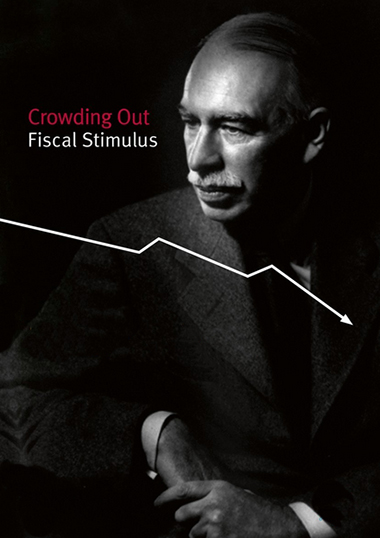Follow the Crowd
Cut taxes or spend? John Heim’s new book says economists have historically gotten it wrong.
 |
|
The cover of John Heim's latest book, featuring a photo of famed 20th Century economist John Maynard Keynes, whose theories Heim tested. |
ALBANY, N.Y. (January 19, 2017) — When looking for ways to stimulate an economy, liberals tend to favor programs that increase government spending while conservatives favor tax cuts. A new book from a UAlbany economist says these efforts have something in common: neither work.
In fact, states Visiting Professor of Economics John Heim in Crowding Out Fiscal Stimulus: Testing the Effectiveness of US Government Stimulus Programs (Palgrave Macmillan, 2017), on the whole, they hurt.
The reason economists have failed to recognize the general futility of these programs, which follow the 1930s demand-driven deficit-financed model created by John Maynard Keynes, said Heim, is their ignoring of the “crowd-out effect.”
“Both Keynesian and classical economists have been arguing for decades over the most important question: Is there anything we can do to stimulate our economy when we get into a recession or a depression,” said Heim. “But most of the people who have argued about have done so as an exercise in economic philosophy — not scientific testing.”
Heim thought a scientific conclusion regarding the effectiveness of Keynesian stimulus was very near when, after receiving his Ph.D. in political economy from UAlbany in 1972, he left academia to work in New York State government and as an economics and econometrics consultant. He was assured because of the advancement of macroeconomics — the study of whole economies rather than individual markets — led by such leaders in scientific economic modeling as Jan Tinbergen and Lawrence Klein.
 |
|
John Heim |
Yet Heim was amazed in 1997, when he returned to academic life, later becoming a clinical professor and head of undergraduate advisement in the economics department of RPI, that the question of what produced economic growth was still the most hotly contested issue in the field.
Believing “there is no such thing as a self-evident truth — it’s all empirical,” he determined to tackle the problem himself, testing the Keynesian theory that increases in government demand through government spending and increases in private demand through tax cuts stimulates an economy.
Using economic date from the years 1960 – 2010, Heim took no shortcuts. “Economists will always look at a study and question it, saying, ‘Yes, but you didn’t control for this or that variable,’” he said. “I wanted to make sure none of those questions could come up after reading this book.”
Heim, who came to UAlbany as a visiting professor in 2013 and retired from RPI a year later, produced models that controlled for interest rates, exports, good economic times and bad, types of spending, types and size of tax cuts, and the size of deficits. He tested four different business cycle controls, three different statistical methods. He broke the time period studied into five decades, applying all variables to each. The grand total was 234 separate tests.
The consistency of Heim’s findings across the board resulted from the application of a deficit variable that reflected a “crowd out” effect. In terms of consumer borrowing, for instance, crowd out occurs because government borrowing from lending institutions to finance the deficit “crowd out” borrowing opportunities that could provide, for instance, a new car, or a new house extension.
His models determined that $1 of growth in government deficits reduces consumer spending an average $0.45. In addition, that dollar reduces business borrowing to finance new machinery or buildings.
The overall negative effect on Gross Domestic Product (GDP) from each dollar of tax cut, Heim found, is between $0.47 and $0.89. For a dollar of spending it is between $0.35 and $0.57. He also found that higher government spending and tax cuts for state and local governments produce similar negative effects.
Applied to the 2009 Obama stimulus program, Helm determined that the net negative effect on GDP was between $340.3 billion and $605.4 billion, plus an increase in unemployment of from 1.26% to 2.26%. (Other factors, such as exchange rates, profits and lower prior year interest rate declines, eased this increase.)
Ironically, one of ways the crowd out problem can be avoided is the often derided use of borrowing from foreign sources to finance deficits, since these funds don’t take away from domestic lenders. Heim noted that incoming President Trump might have some success by enticing industries back to the U.S. with lower taxation to overcome America’s higher labor costs.
But the tried and accepted as true stimulative methods of Republicans and Democrats — historically backed by thousands of economists — might best be left aside, according to the empirical determinations of John Heim.
![]() For more news, subscribe to UAlbany's RSS headline feeds
For more news, subscribe to UAlbany's RSS headline feeds
A comprehensive public research university, the University at Albany-SUNY offers more than 120 undergraduate majors and minors and 125 master's, doctoral and graduate certificate programs. UAlbany is a leader among all New York State colleges and universities in such diverse fields as atmospheric and environmental sciences, business, education, public health,health sciences, criminal justice, emergency preparedness, engineering and applied sciences, informatics, public administration, social welfare and sociology, taught by an extensive roster of faculty experts. It also offers expanded academic and research opportunities for students through an affiliation with Albany Law School. With a curriculum enhanced by 600 study-abroad opportunities, UAlbany launches great careers.


